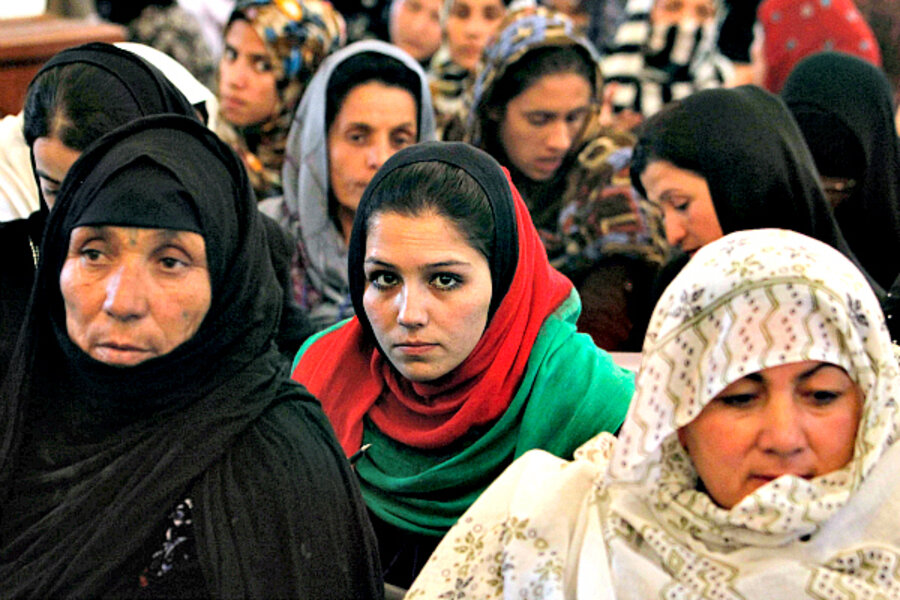Afghan women write powerful poetry – even amid war
Loading...
Despite constant dangers, Afghan women’s poetry continues to flourish. One outlet for women’s poetry is Mirman Baheer, Afghanistan’s largest literary society for women. Mirman Baheer operates in Kabul with over 100 members. Its members are generally educated and employed; they are professors, parliamentarians, journalists, and scholars.
Approximately 300 of Miram Baheer’s members live in the outlying provinces — Khost, Paktia, Maidan Wardak, Kunduz, Kandahar, Herat, and Farah — where the group functions in secret. Many who cannot safely travel to meet together listen to radio programs broadcast by Mirman Baheer and the Afghan Women’s Writing Project.
“We recruit only through word-of-mouth and delete any content that might be used to identify our writers,” says Richelle McClain, director of the Afghan Women’s Writing Project.
The Afghan Women’s Writing Project (AWWP) was founded in 2009. Today, 160 Afghan women across five provinces are enrolled in AWWP’s workshops, including a new workshop for teenagers and a Dari writing program. While security is an omnipresent concern, dwindling financial support is one of their greatest challenges. “We just lost 75 percent of our funding because of the US withdrawal,” says McClain.
In addition to radio broadcasts and writing programs, the AWWP collects oral stories from illiterate Afghan women, which are edited and published on the organization’s blog.
Before the 2014 elections in Afghanistan, the AWWP plans to partner with IFES Afghanistan (International Foundation for Electoral Systems) to promote political writings by local women through digital, print, and radio networks. They will also run special broadcasts featuring interviews with female candidates and programs about how election results will impact Afghan citizens.
For many rural women in Afghanistan, these secret networks and the poetry broadcasts are their only form of education. U.N. investigations revealed that only 12 percent of Afghan women are literate.
But thanks to volunteer translators and journalists contemporary Afghan women’s poetry can now reach global audiences. For example, the June 2013 issue of Poetry magazine was dedicated to landays – vitriolic, two-line verses traditionally recited by Afghan women at the river, the well, or private gatherings.
This collection came from years of investigative reporting by journalist Eliza Griswold. She journeyed to Afghanistan with photographer and filmmaker Seamus Murphy. On July 30, 2013, the Pulitzer Center will host “I Am the Beggar of the World,” a presentation of Griswald and Murphy’s work at the Culture Project in New York City.
A free exhibit at the Poetry Foundation Gallery in Chicago, "Shame Every Rose: Images of Afghanistan," features many of these landays and images. The exhibit is open to the public through August.
“Sharing this poetry could endanger the poets’ lives,” says Don Share, editor of Poetry magazine. “Still, they gave these poems willingly.”
The tradition of landays provides some level of anonymity for women because they are collective. They are recited and shared rather than attributed to a single poet.
Even so, in modern Afghanistan, poetry can be dangerous. Over the past year, several young Afghan poets were killed by their male relatives. A young Mirman Baheer member who called herself Rahila Muska burned herself to death in protest after her brothers found her writing poetry and brutally attacked her. Her real name was Zarmina. She often recited this landay over the phone to members of Miram Baheer:
“You sold me to an old man, Father.
"May God destroy your home, I was your daughter.”
Landays derive their power from shrewd layers of tension between the poet’s inner and outer world. They can explore rage, sarcasm, irony, loss, separation, and desire. Many of the poems are humorous, filled with bawdy sexual imagery.
Whatever the subject, a landay lilts from word to word in a short lullaby with scathing, layered meaning. These poems come from a long legacy of Afghan women’s literature.
“The Afghan woman poet predates the American or European female poet,” says Zohra Saed, an Afghan-American poet living in New York City. “Consider the poet queen Rabia Balkhi.” Legend has it this 11th-century Afghan used her last drop of blood to write poems.
“Afghan women’s poetry is unique because it must respond to create change,” says Saed. “Within our communities and also to change outside perceptions. It is the poetry of witness, of trauma, of memory, and of struggle to be seen as individuals.”
Saed recounted the time she edited a collection of literature by Afghan writers around the world. Before it was finished, an American radio station published a CD of the collection without her permission. They listed her as the editor and printed a photograph of an impoverished child on the cover.
“When people are interested in Afghan women’s poetry, it is presented as poetry by the same women the world has imagined rescuing over the past 20 years,” Saed says.
She took legal action to recall the copyrighted anthology, then focused it exclusively on Afghan-American writers. “There were also women poets who were not part of the war,” she says. “Writers raised abroad, their aesthetics and poetic voice is very different.”
Today, Afghan literature is fragmented by linguistic, cultural, and geographic divides. Some of the world’s most prominent Afghan writers live outside their fatherland and write in English. Many female writers in Afghanistan come from the urban elite, often educated in Western universities. Poems by women in rural Afghanistan are rarely published. Groups like the Afghan Women’s Writing Project and the Poetry Foundation are working to bridge this divide.
“Poetry is not only for the classroom and elite art circles,” says Mr. Share, editor of Poetry magazine. “Poetry is an essential part of life, the only way these women can share their experiences. These poems are electrifying and relevant.”
He hopes readers will realize that, even in the digital age, poetry can wield tangible power.







